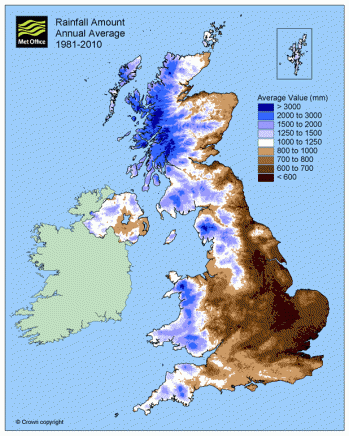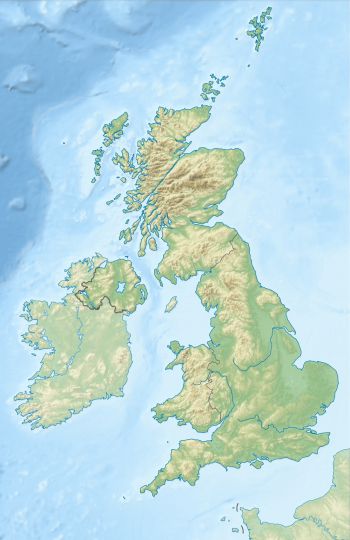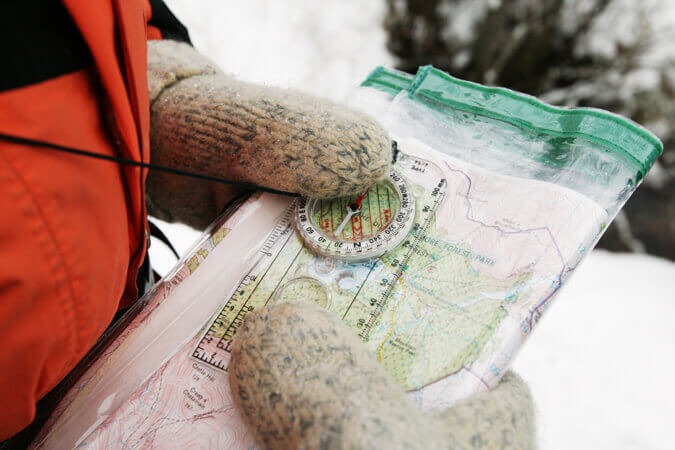Scottish weather has it’s own reputation. Everyone who comes to visit seems to be prepared to be cold and wet. Many are pleasantly surprised when they come to stay with us. Scotland has a great many ambassadors who spread the world all over the world but there’s no getting away from the fact that it is a green and beautiful land and that green comes at a price sometimes. However, it is possible to minimise the effect a poor weather day could have on your vacation.
A quick comparison between a relief map of Scotland and the annual rainfall map shows a very close correlation. The higher you go the higher the annual rainfall. The altitude of the land can change considerably in a single mile and so can the amount of rainfall both on an annual and daily basis depending on the prevailing wind direction.
The point is, the Scottish Highlands are packed with micro climates and by jumping in the car and placing big mountains between you and the prevailing wind direction, you can massively improve the weather you’ll experience for your day. It can be the difference between frequent heavy down pours and sunshine with the odd very light shower. If active frontal systems are sweeping across the country, well you’re probably going to experience some kind of precipitation at some point wherever you are but if they’ve all passed through and it’s just an air-stream scenario then some judicious planning can pay handsome dividends.

I remember turning up at a house in Glenfeshie one April. I was to guide the group of ladies up from the London area. The forecast for the N. Cairngorms was not good: 70 mph NE winds, blizzards above 800m and torrential rain. I arrived to the gutters overflowing but having studied the weather closely I suggested we jump into the cars for an hour and drive around to Pitlochry on the leeward side of the range to do Ben Vrackie. The suggestion wasn’t greeted with any enthusiasm and possibly a certain amount of doubt but the thought of an hour in a dry bus was better than an extra hour walking in the heavy rain.
As soon as we passed over Drumochter Pass the weather started to improve (as is often the case) and by the time we got around to Pitlochry we were in sunshine to the comment of “Andy, haven’t you done well”. We had clear views from the summit, albeit in a strong bitter wind. On passing back over the pass we drove back into the bad weather. ‘Had it been wet and horrible all day’ I asked Rebecca, my partner. “Yes’ was the answer.

The prevailing weather/wind direction makes a big difference. If there’s bad weather on the way make sure you’re on the sheltered lee side of big mountain ranges. One of the most common comments made by visitors is how changeable the weather is.Don’t judge the days’ weather by what’s happening at breakfast.
So when it comes to planning your tour, if you can remain flexible and not book things too far in advance it can often make a big difference. Avoiding the high season from the middle ofJuly until the end of August can be a big help in this regard. April & May can produce some of the best weather.
The vast majority of Scotland’s bad weather comes in from the south and west. You will notice the east side of the country is considerably drier than the west. In fact the west coast ofScotlandcan receive up to 3 times the annual rainfall of the east. So by basing yourself, for example, in Strathspey or in the North East side of the Cairngorms National Park you can often greatly increase your chances of experiencing better weather. Also, with easy access to the main road routes to Ullapool in the North West Highlands and Fort William in the West Highlands are only 1hr 40mins and 1hr 30mins away respectively from Aviemore it’s easy to make a foray into these areas.
This is you buying into in-depth local knowledge of suitable locations with regards to the weather conditions. Adventure activities also provide you with the opportunity to immerse yourself in the beautiful landscapes and amazing wildlife of the Scottish Highlands.
Adventure Tour Operators in Scotland
Highlands and Islands Adventures (mountain biking specialists)
Walking holiday providers in Scotland
Nothing about mountain navigation is rocket science. Then again it is not a god given talent either. It does though require both a good understanding and the right approach to deal with the worst conditions in the mountains.
In good conditions with good visibility you can quite successfully navigate without reaching for your compass. Neither will you need to resort to the “dead reckoning” techniques of timing and pacing to gauge your distance. By relating the features on the map to those on the ground you can safely get to your destination. Some of those features will be man-made like field boundaries. Other more obvious natural features include streams or ponds or lakes. But many of those features, especially in Scotland, will be made up of a combination of a change in gradient and a change in slope aspect (which way the slope faces).
Take a little rounded hill (knoll) for instance: as you rise up onto it the gradient will increase before flattening out on the summit.The gradient then increases again as you drop down the other side. It will be shallower again at the bottom. If you were to walk around its flanks you would continually experience a change in slope aspect. If we think about other features like ridges, spurs, valleys, gullies, saddles, etc, they’re all a combination of changing gradient and slope aspect. Both slope aspect and gradient are indicated by contour lines.

Map reading in the Cairngorms
Accuracy in a particular skill is important. However the key aspect of accurate Mountain Navigation is your ability to manage error. It’s a fatal mistake rely too much on the absolute accuracy of a few skills. Don’t ignore the importance of applying techniques or strategies that reduce or negate the effect of error. If we think how most folks get lost on the mountains it’s when they are trying to navigate to a point beyond their range of visibility. One strategy is to keep your navigational legs short. A 10% error in distance or direction over 2 km will be 4 times that over 500m. But if we are to do this we will need to be able to identify more way-marking points. This, especially in Scotland, often comes down to contour features.

Dachstein mitts don’t necessarily mean that you won’t be able to use a compass or to navigate, as shown by our director Andy Bateman
In winter whiteout conditions where you are, let’s say making a descending traverse, where you have no horizon and loose the definition of slopes and other features, it can be very difficult to stay on a compass bearing. But again it may be a change in the gradient or slope aspect which maybe the first (and maybe only) indication that you have drifted off your compass bearing. Bad visibility of course encourages you to abandon any attempt at interpreting the lie of the land. This is the last thing you want to do and it’s even more important that you keep a close eye on the terrain.

Test your limits, within your means
It all comes back to you contour interpretation. This is the crux of good mountain navigation and around which all the other navigational skills like compass bearings fit and relate. Of course this all makes perfect sense when you consider, by definition, mountains are composed of slopes and in turn those slopes must have an aspect and gradient. It is very important that all the various navigational skills and techniques are related to each other and not taught in isolation. One of the common points of failure on Summer ML assessments is when candidates place an over reliance on compass bearings and timing and pacing techniques and don’t develop their contour interpretation skills. Your “dead reckoning” skills are of course important and you would never be without you compass on the hill but they are in effect auxiliary skills, albeit very important ones, to your contour interpretation.
Andy Bateman, Scot Mountain Holidays, 26/3/15. (updated 14.01.2020)
Mountain Navigation by Peter Cliff:
Weather for Hillwalkers and Climbers by Malcolm Thomas
Mountaincraft and Leadership by Eric Langmuir
Hillwalking the official handbook of the mountain leader by Steve Long
Winter Skills: Essential walking and climbing techniques by Andy Cunningham
Useful links:
Mountaineering Council of Scotland:
British Mountaineering Council:
British Association of International Mountain Leaders:
Mountain Training Association:
All content © Copyright Scot Mountain Holidays 2025
Responsive web design by Summit Web Solutions